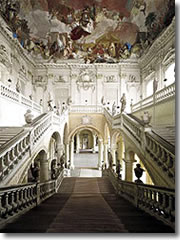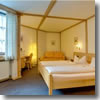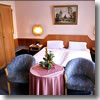Würzburg
A wine town with a gloriously frescoed palace on Southern Germany's Romantic Road

Würzburg guide
• See
• Stay
• Eat
• Plan Würzburg is a small, friendly university city and the capital of Franconia, a region renowned for its fine, dry white wines.
Founded in the 4th or 5th century and converted to Christianity soon after, the city was ruled by princely bishops right until the 20th century.
Almost the entire town was flattened by an Allied bombing raid on March 16, 1945. The air raid's human toll was even worse—all but 5,000 of the city's 108,000 residents perished, and the city became known as Grab am Main, or "Grave on the Main."
A few of Germany's greatest baroque buildings remained standing, however.
The Residenz palace

The staircase and Tiepolo ceiling at the Würzburg Residenz. At the east end of town is Wurzburg's biggest draw, the huge baroque Residenz.
It was built for the ruling bishops in 1720 and contains an elegant staircase (on the ceiling above it, the Italian master Tiepolo painted the world's largest fresco, at 7,287 square feet).
Also don't miss the fanciful and ornate Court Chapel, or Hofkirche Würzburg, a festival of twisty columns and gilded stucco work.
The Residenz (tel. +49-(0)931/355-170, www.residenz-wuerzburg.de) is open Apr–Oct daily 9am–6pm, Nov–Mar daily 10am–4:30pm. Guided tours in English are available at 11am and 3pm.
The Festung Marienberg fortress
Dominating the town from a hill rising across the Main River just west from the main part of Würzburg, is the Festung Marienberg (pictured a the top of the page).
This fortress/residence of the city's bishops from 1253 to 1720 contains the tiny 8th-century Marienkirche church and two small museums, one of winemaking and Riemenschneider sculptures; the other of typical Franconian household objects and clothing from past eras.
The Festung Marienberg (tel. +49-(0)931/355-1750, www.schloesser.bayern.de) is open Apr–Oct Tues–Sun 9am–6pm. Guided tours in English are available at 3pm daily.
Where to eat in Würzburg
There's no finer place to sample Franconian wines than in the Juliusspital Weinstuben, where the set-price lunches and inexpensive main courses are excellent. (Juliuspromenade 19, tel. 0931/54-080, www.juliusspital.de)
Where to stay in Würzburg
 Hotel Grüner Baum [€€], right under the Marienberg fortress, with free Internet, exposed stone walls, and pleasantly plain Franconian pinewood-accented rooms. Double rooms start at €105. Zellerstrasse 35-37; tel. +49-(0)931/450-680, www.gruener-baum-wuerzburg.de.
Hotel Grüner Baum [€€], right under the Marienberg fortress, with free Internet, exposed stone walls, and pleasantly plain Franconian pinewood-accented rooms. Double rooms start at €105. Zellerstrasse 35-37; tel. +49-(0)931/450-680, www.gruener-baum-wuerzburg.de. ![]()
 Hotel Stankt Josef [€], with modern, function guest rooms and WiFi in the center of town. Double rooms start at €98. Semmelstrasse 28–30; tel. +49-(0)931/308-680; www.hotel-st-josef.de.
Hotel Stankt Josef [€], with modern, function guest rooms and WiFi in the center of town. Double rooms start at €98. Semmelstrasse 28–30; tel. +49-(0)931/308-680; www.hotel-st-josef.de. ![]()
» More hotels in Würzburg
Continuing on the Romantic Road
If you follow the traditional Romantic Road (and on southbound buses) to Rothenburg, you'll pass—about a mile past Creglingen—the Herrgottskapelle, a church containing one of Riemenschneider's best carved wooden altarpieces.
|| Southbound to Rothenburg »
Tips
- Planning your time: It takes a good two to three hours to see the major sights of Würzburg. In a hurry, head straight for the Residenz, and you can do Würzburg in an hour or so.
- Visitor information: The Würzburg tourist office is in the Falkenhaus on the Market Square (tel. +49-(0)931/372-355, www.wuerzburg.de).
- City tours: The tourist office offers 1.5-hour tours of the city in English at 11am in summer (€6), and 45-minute tours of the Residenz Palace at 11am and 3pm (€7.50, includes admission).
- Book a Romantic Road tour: Perhaps the easiest way to tour the Romantic Road if you don't have a car (and don't want to be stuck on the bus's schedule) is to let others take care of the logistics and transportation—and provide you with a tour guide. You can book these at a discount via our partners Viator.com:
Day tours
- Wurzburg Day Tour from Frankfurt
- Full Day Tour to Rothenburg from Frankfurt
From Munich to Frankfurt
- Wurzburg Day Tour from Frankfurt
- 2 day overnight Munich to Frankfurt - Romantic Road, Rothenburg
- 3 day Munich to Frankfurt Tour - Romantic Road, Rothenburg, Hohenschwangau, Neuschwanstein
- 3 day Munich to Frankfurt - Romantic Road, Heidelberg, Rothenburg
- 4 day Munich to Frankfurt - Romantic Road, Linderhof, Hohenschwangau, Neuschwanstein
From Frankfurt to Munich - 2 day overnight Frankfurt to Munich - Romantic Road, Rothenburg
- 3 day Frankfurt to Munich - Romantic Road, Rothenburg, Hohenschwangau, Neuschwanstein
- 3 day Frankfurt to Munich - Romantic Road, Heidelberg, Rothenburg
- 4 day Frankfurt to Munich - Romantic Road, Hohenschwangau, Neuschwanstein
- 5-Day Frankfurt to Munich - Rothenburg, Augsburg, Zugspitze
Related Articles |
|
This article was by Reid Bramblett and last updated in December 2011.
All information was accurate at the time.
Copyright © 1998–2013 by Reid Bramblett. Author: Reid Bramblett.

Falkenhaus, on the Market Square
Tel. +49-(0)931/372-355
www.wuerzburg.de
TOURS
Day tours
• Wurzburg Day Tour from Frankfurt
• Full Day Tour to Rothenburg from Frankfurt
From Munich to Frankfurt
• 2 day overnight Munich to Frankfurt - Romantic Road, Rothenburg
• 3 day Munich to Frankfurt Tour - Romantic Road, Rothenburg, Hohenschwangau, Neuschwanstein
• 3 day Munich to Frankfurt - Romantic Road, Heidelberg, Rothenburg
• 4 day Munich to Frankfurt - Romantic Road, Linderhof, Hohenschwangau, Neuschwanstein
From Frankfurt to Munich
• 2 day overnight Frankfurt to Munich - Romantic Road, Rothenburg
• 3 day Frankfurt to Munich - Romantic Road, Rothenburg, Hohenschwangau, Neuschwanstein
• 3 day Frankfurt to Munich - Romantic Road, Heidelberg, Rothenburg
• 4 day Frankfurt to Munich - Romantic Road, Hohenschwangau, Neuschwanstein
• 5-Day Frankfurt to Munich - Rothenburg, Augsburg, Zugspitze

